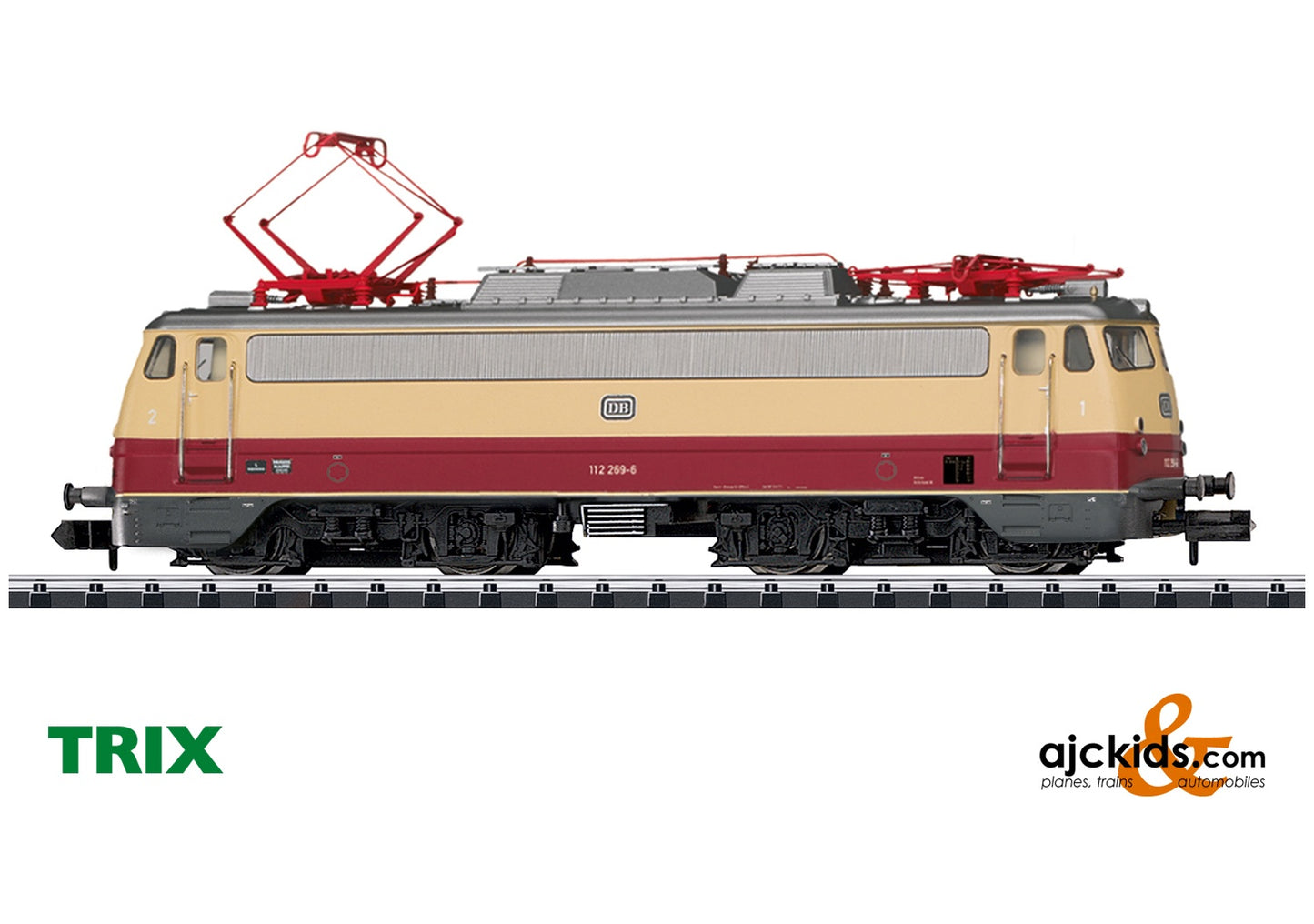Trix 16100 - Class 112 Electric Locomotive (Sound)
Prototype: German Federal Railroad (DB) standard design electric locomotive, road number 112 269-6. Express locomotive with aerodynamic ends, including the so-called "Bügelfalte" / "Pants Crease". Basic paint scheme in crimson/ivory. Continuous rain gutter, skirting, and buffer cladding included. The locomotive looks as it did around 1974.
Use: Passenger trains in long-distance service and occasionally in commuter and freight service.
Highlights
- Digital sound with many functions.
Product description
Model: The locomotive has a built-in digital decoder and sound generator for operation with mfx and DCC. The motor has a flywheel. 4 axles powered. Traction tires. The warm white LED headlights and marker lights change over with the direction of travel. They and the cab lighting can be controlled in digital operation. The locomotive has a close coupler mechanism. It also has separately applied grab irons.
Length over the buffers 103 mm / 4-1/16".
Publications
- New items brochure Minitrix 2021Prototype information
In order to take up previous luxury, the DB decided in 1960 to build an exclusive and especially comfortable set of cars for the "Rheingold" and the "Rheinpfeil" associated with it. Since the new "Rheingold" could now be pulled by electric locomotives due to progressive electrification in the German area from Basle to Duisburg, there also had to be new locomotives. The DB thus decided on a modified version of the recently proven E 10, which in the future was to be given a more streamlined superstructure.
Starting in March of 1963, locomotives with a top speed of 160 km/h / 100 mph and with road numbers E 10 1265-1270 were available for the "Rheingold" thanks to a gearing change and Henschel trucks adapted for the purpose, the locomotives naturally in the elegant two-color "Rheingold" paint scheme of cobalt blue / beige. The more streamlined body with the characteristic "Pants Crease" look on the ends that was used for the first time was also applied starting in 1963 to all of the regular production E 10 locomotives. The six Rheingold E 10.12 units were followed in 1963/64 by another five units, the E 10 1308-1312, also in cobalt blue / beige.
After the "Rheingold" and the "Rheinpfeil" were changed into TEE trains, the DB applied the crimson/beige TEE paint scheme to the E 10.12 units and their car sets. A last series of these 160 km/h / 100 mph fast units was delivered in 1968 with the new class designation 112 485-504 but with regular production trucks adapted to the higher speed and again in crimson/beige. With the start of the summer schedule for 1968, all of the locomotives were used in premium passenger service emanating from Frankfurt/Main, particularly TEE and F-Zug long-distance expresses.
The new delivery of the regular production class 103 locomotives to the Frankfurt/Main base starting in 1970 meant that the class 112 units were gradually removed from premium service by 1972. The former stars now moved to the Dortmund base where they were still used at least in part to pull premium express trains. Yet various uses in regional and freight service were also now part of the program.
Over the course of their years in service, these units kept changing their paint scheme and frequently their class designations too. Road numbers 112 485-504 thus became 114 485-504 in 1988 and starting in 1991 they had the designation 110 485-504 after E 10 units were taken out of service. The remaining class 112 units became the class 113 in 1992. Starting in 2005 the last class 113 units of the DB Regio went to DB Autozug, where the last two former Rheingold/Rheinpfeil locomotives (113 268 and 309) were removed from service on June 2, 2014. Both were preserved, were sold to TRI Train Rental, Inc., completely overhauled in the meantime and largely restored to their original condition, however in the crimson/beige TEE paint scheme. In the future, they are to pull among other things the AKE Rheingold Tourism trains.
In addition, road numbers 113 311 (former E 10 1311) and 110 488 (former 112 488) are still in existence at the DB Museum in Koblenz and in Rottweil under the care of the "Die Bügelfalte 110 488-4" Association.
Features
Warning
| DCC | SX2 | SX | MFX | |
|---|---|---|---|---|
| Headlight(s) | X | X | ||
| Locomotive whistle | X | X | ||
| Electric locomotive op. sounds | X | X | ||
| Whistle for switching maneuver | X | X | ||
| Direct control | X | X | ||
| Sound of squealing brakes off | X | X | ||
| Rear Headlights off | X | X | ||
| Station Announcements | X | X | ||
| Front Headlights off | X | X | ||
| Station Announcements | X | X | ||
| Conductor's Whistle | X | X | ||
| Brake Compressor | X | X | ||
| Blower motors | X | X | ||
| Letting off Air | X | X | ||
| Doors Closing | X | X | ||
| Special Function | X | X | ||
| Sanding | X | X | ||
| Headlight(s) | X | X | ||
| Station Announcements | X | X | ||
| Station Announcements | X | X | ||
| Dialog | X | X | ||
| Conductor – instructions | X | X | ||
| Special light function | X | X | ||
| Main Relay | X | X | ||
| Blower motors | X | X | ||
| Special sound function | X | X | ||
| Special sound function | X | X | ||
| Rail Joints | X | X | ||
| Sound of Couplers Engaging | X | X |
EAN/UPC: 4028106161001



